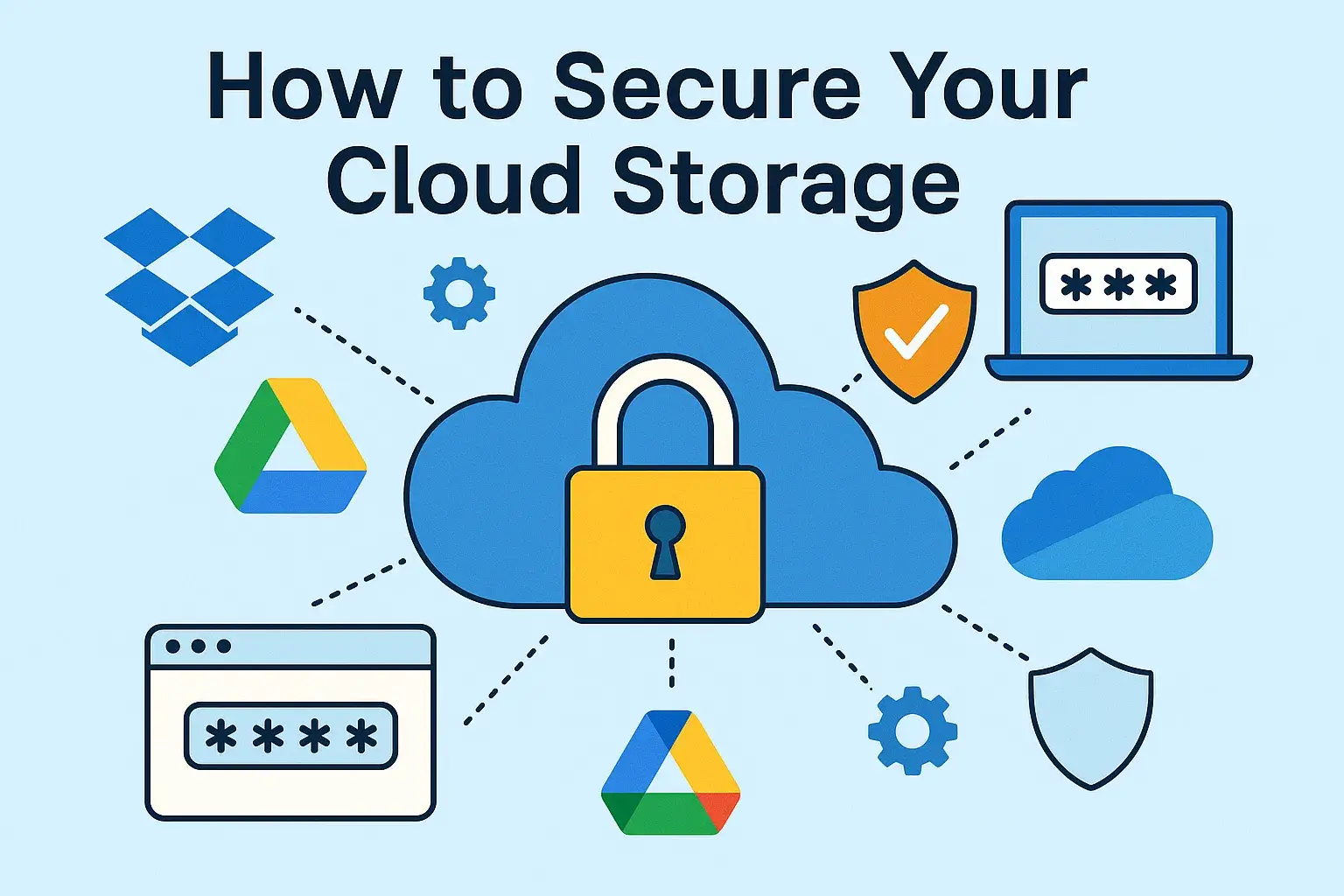🎬 The Cloud You Forgot to Lock
It started with a photo — a childhood memory synced to the cloud. Then came spreadsheets, contracts, scanned IDs, late-night diary entries saved as drafts. All uploaded. All safe. Or so it seemed.
Until the silence broke.
One morning, files vanished. A tax document leaked online. Passwords changed without warning. An email came next: “We have your data. Pay, or it goes public.”
The cloud — once invisible and convenient — had turned into a weapon.
In 2025, your cloud account is not just storage. It’s the nerve center of your digital life. It knows your habits, your contacts, your secrets, and your vulnerabilities. And unlike your laptop, it never powers off. It’s always online — and always exposed.
Cybercriminals know this. They don’t need to “hack” in the movies’ sense. They log in, using old leaks and weak passwords. They hijack sessions, bypass 2FA, and exploit shared links you forgot even existed.
This article is your firewall.
We’ll show you how cloud breaches actually happen — and how to stop them cold.
Lock in.
🚩 Why Cloud Security Matters
Cloud storage has become the modern filing cabinet. You store everything there:
✔️ Personal documents
✔️ Photos and videos
✔️ Work files
✔️ Financial records
✔️ Backups from your phone and devices
If a hacker gains access to your cloud account, the damage can be devastating:
- Identity theft
- Financial fraud
- Extortion with private data
- Loss of priceless memories
According to the Verizon Data Breach Investigations Report 2023, stolen credentials were involved in 83% of breaches related to web applications — including cloud services.
⚠️ Disclaimer
This article is written for educational and ethical purposes only. Its goal is to help readers secure their cloud storage accounts against unauthorized access, breaches, and data loss.
🏴☠️ How Hackers Attack Cloud Accounts
→ Credential stuffing: Using passwords leaked from other breaches (source: FBI IC3 Report 2023).
→ Phishing: Fake emails or pages that trick you into entering credentials.
→ Social engineering: Manipulating support agents into resetting passwords.
→ SIM swapping: Taking control of your phone number to bypass 2FA.
→ Session hijacking: Exploiting browser sessions to skip login checks.
→ Malware: Stealing session tokens or credentials directly from infected devices.
🔸 ASCII Diagram — Cloud Account Attack Flow
Cloud Account Attack Flow:
Leaked Credentials
↓
Login Attempt
↓
2FA Bypassed or Absent
↓
Access
↓
Data Theft or Ransom
🔸 Table — Cloud Threats vs Protections
| Threat | Example | Defense Strategy |
|---|---|---|
| Credential Stuffing | Dropbox 2012 Breach | Use unique, strong passwords + 2FA |
| SIM Swapping | Crypto wallet drained via cloud reset | Enable SIM lock + Port-Out Protection |
| Shared Link Exposure | Public links to sensitive documents | Regularly audit and remove shared links |
| Session Hijacking | Token theft via malware | Use endpoint protection + revoke old sessions |
🔥 12 Steps to Secure Your Cloud Storage (Google Drive, Dropbox, OneDrive)
✅ 1. Use a Strong, Unique Password
→ A weak password is the easiest way in.
✔️ Recommended by Google and Microsoft:
→ Minimum 16 characters.
→ Mix of uppercase, lowercase, numbers, and symbols.
→ Never reuse passwords — even once.
→ According to NIST Digital Identity Guidelines (SP 800-63B), passphrases like “CorrectHorseBatteryStaple!” are effective.
✅ 2. Enable Two-Factor Authentication (2FA)
→ Absolutely non-negotiable.
✔️ Supports:
→ Google Drive: Google Authenticator, SMS (avoid), or Security Keys.
→ Dropbox: Authenticator apps or hardware keys.
→ OneDrive: Microsoft Authenticator, SMS (avoid), or Security Keys.
→ FBI IC3 notes that 2FA stops 95% of account takeover attempts.
✅ 3. Use Hardware Security Keys for Maximum Protection
→ Keys like YubiKey or Google Titan are phishing-proof.
✔️ Both Google and Microsoft report that no account protected by a security key has been successfully phished (source: Google Advanced Protection Program Whitepaper).
✅ 4. Audit Connected Devices and Apps
→ Go to your cloud settings and check:
✔️ Devices logged in
✔️ Third-party apps connected
→ Remove anything suspicious or unused.
✅ 5. Monitor Recent Activity
✔️ Look for unfamiliar logins, strange IP addresses, or unusual locations.
→ Google, Dropbox, and Microsoft all offer login history features.
✅ 6. Regularly Backup Your Cloud Data Offline
→ Relying solely on the cloud is risky.
✔️ Use encrypted external drives or secure local backups.
→ According to the Cybersecurity & Infrastructure Security Agency (CISA), “offline backups are critical for ransomware resilience.”
✅ 7. Encrypt Sensitive Files Before Uploading
→ Even if the cloud gets hacked, the files stay protected.
✔️ Use tools like:
→ Cryptomator (open-source, user-friendly)
→ VeraCrypt for complex encryption
→ NordLocker or AxCrypt
→ “Encrypting files locally before uploading is an essential layer of protection,” states EFF Privacy Guide 2024.
✅ 8. Disable Automatic Sync for Sensitive Folders
→ Don’t let everything from your desktop or phone sync blindly.
✔️ Manually choose what gets uploaded.
✅ 9. Lock Down Account Recovery Options
→ Attackers often bypass passwords by exploiting recovery settings.
✔️ Audit recovery emails, phone numbers — ensure all have 2FA.
✔️ Remove outdated or unused recovery methods.
✅ 10. Remove Shared Links You Don’t Need
→ Check “Shared with others” or “Shared links” sections.
✔️ Remove links that are public or no longer needed.
→ Dropbox, Google Drive, and OneDrive all allow full link audits.
✅ 11. Harden Your Email Security
→ Your email is the key to resetting cloud passwords.
✔️ Apply everything from your Wi-Fi and email security guides:
→ Strong password
→ 2FA (hardware key recommended)
→ Check for breaches (via Have I Been Pwned)
→ “Attackers target your email first — then take your cloud,” confirms the FBI IC3 2023 report.
✅ 12. Remove Old Devices and Close Unused Sessions
✔️ If you lose a phone or laptop, log into your cloud and revoke access for that device immediately.
🔸 Table — Cloud Service Comparison
| Service | 2FA Support | Encryption at Rest | End-to-End Encryption | Auto Sync Options | Access Controls |
|---|---|---|---|---|---|
| Google Drive | Yes (App, SMS, Hardware Key) | Yes | ❌ (Server-side only) | Full-device sync | Folder/file permissions |
| Dropbox | Yes (App, Hardware Key) | Yes | ❌ (Server-side only) | Selective sync available | Shared link & team settings |
| OneDrive | Yes (App, SMS, Hardware Key) | Yes | ❌ (Server-side only) | Auto photo & doc backup | Password-protected sharing |
| Tresorit | Yes (App, Hardware Key) | Yes | ✅ (E2EE by default) | Manual or selective sync | Granular user/group control |
🚫 Common Mistakes to Avoid
- ❌ No 2FA — the #1 cause of cloud account breaches.
- ❌ Relying on SMS-based 2FA — vulnerable to SIM-swapping.
- ❌ Keeping sensitive files unencrypted in the cloud.
- ❌ Assuming your cloud provider alone protects you — encryption is your job.
- ❌ Ignoring shared links — they often expose data to anyone with the link.
🏴☠️ Real-World Example — The Dropbox Leak
In 2012, Dropbox suffered a breach affecting over 68 million users.
→ The cause? An employee reused a password from another breached service.
→ Hackers stole email addresses and hashed passwords, then tried credential stuffing attacks on other platforms (source: Dropbox Incident Report 2016).
→ Lesson: Password reuse is deadly.
🔥 Pro Tips for Maximum Cloud Security
- ✔️ Store encryption keys separately from your cloud.
- ✔️ Disable link sharing by default.
- ✔️ Use privacy-first alternatives like Tresorit or Sync.com for highly sensitive data.
- ✔️ Combine VPN usage with secure cloud habits.
- ✔️ Regularly download your cloud data audit report (available on most platforms).
🚀 Checklist — Secure Your Cloud Storage
- 🔲 Strong, unique passwords (never reused)
- 🔲 2FA enabled (prefer hardware keys)
- 🔲 Audit connected devices and apps
- 🔲 Monitor login activity
- 🔲 Keep offline, encrypted backups
- 🔲 Encrypt sensitive files before upload
- 🔲 Disable auto-sync for private folders
- 🔲 Lock recovery methods with 2FA
- 🔲 Remove public/shared links you don’t need
- 🔲 Secure your email (your cloud depends on it)
- 🔲 Remove old device sessions
🏆 Final Thoughts
Your cloud is your second brain. It holds your life, your memories, your work — everything.
Yet most people protect it worse than their Netflix account.
→ A password isn’t enough. Cloud security requires multiple layers: strong credentials, two-factor authentication, encryption, and awareness.
Hackers don’t break into the cloud — they log in. Don’t make it easy for them.
✅ Final Note
Sources referenced directly in this article:
- Verizon Data Breach Investigations Report (DBIR) 2023
- FBI Internet Crime Complaint Center (IC3) Report 2023
- Google Advanced Protection Program Whitepaper
- Dropbox Security Incident Report 2016
- CISA Cloud Security Guidelines 2024
- Electronic Frontier Foundation (EFF) Privacy Guides
